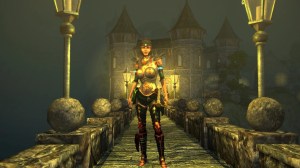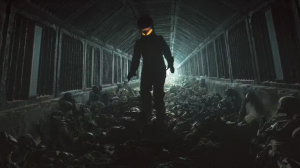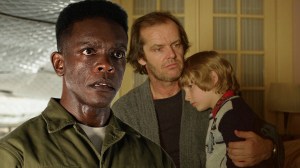When it debuted in 1959, The Twilight Zone gave genre television its first major evolution. While Westerns and detective shows were popular, science fiction and fantasy struggled; the budgets usually required for truly fantastic tales were too much for early television, and most of the episodes produced focused on ‘science’ more than ‘fiction.’ Tales of Tomorrow (1951-1953) is probably the closest of The Twilight Zone‘s ancestors, taking popular science fiction writers’ of the period’s stories and adapting them in 30-minute episodes. The Twilight Zone‘s key ingredient was its creator, Rod Serling: he was a visionary storyteller, and emphasized that The Twilight Zone should be about real world problems, using the science fiction and fantasy genres to tackle subjects that might otherwise not make the air.
Videos by ComicBook.com
Today, The Twilight Zone is still legendary; it has many descendants in television, both direct and spiritual; most recently, a 2019 reboot on Paramount+ with Jordan Peele at the helm. The Twilight Zone, arguably, also got lucky; it was usually running in syndication somewhere, and now, it’s easy to find on streaming services. You can find Tales of Tomorrow out there, too, now, but it was recorded live at the time; The Twilight Zone also benefitted from turning away from the anthology tradition of the time, which was live productions. Playhouse 90, where Rod Serling worked as a writer before The Twilight Zone, did hour and a half long episodes, and each of them were live. (Playhouse 90 is still a fascinating watch; while it is not available in its entirety anywhere, you can find a lot of episodes on YouTube.)
If you’re looking for something to scratch that The Twilight Zone itch, be it science fiction, episodic anthology, or something retro, here are seven shows to watch after finishing The Twilight Zone.
Night Gallery

If you’re going to follow The Twilight Zone, you’d be hard-pressed not to start with its literal television little brother. While Rod Serling had less artistic control on Night Gallery, he still wrote episodes and acted as host. Night Gallery ran from 1969 to 1973 and focused primarily on telling horror stories in the anthology format The Twilight Zone used. Its pilot features directing from a young Steven Spielberg and one of the last performances of Joan Crawford. The horror stories ranged from the supernatural to the more mundane, including one of its most hailed episodes, “They’re Tearing Down Tom Riley’s Bar.”
Individual episodes of Night Gallery can be rented on various services; it also has received a complete release on DVD and Blu-Ray.
The Outer Limits

It originally aired from 1963 to 1965 and was relaunched 30 years later: The Outer Limits often went ‘bigger’ than The Twilight Zone did when it came to spectacle, and it wasn’t as focused on parables about real-world issues. The first season had a monster of the week, while the second season became more about science fiction. Its reboot in 1995 is also worthy of inclusion here; while none of The Twilight Zone revivals have quite lived up to the original, The Outer Limits‘s revival had the benefit of bigger budgets and better tech for special effects. The first episode is based on the George R. R. Martin short story “Sandkings;” while Martin himself had stopped writing scripts for TV at that point, it might be the first prose of his to be adapted for TV.
The original Outer Limits can be found on Pluto TV and the Roku Channel for free; the revival can be found on the Roku Channel.
Twin Peaks

Twin Peaks is one of the only traditional TV dramas on this list. The David Lynch series earns its spot because every moment in the fictional Pacific Northwest town kind of feels like what life must be in a Twilight Zone episode. Twin Peaks never shied away from feeling a little ‘off,’ and it contrasts with its early 90s origin. The original Twin Peaks, while having the over-arching question of ‘Who Killed Laura Palmer?’, did have a more procedural feeling to it; it had room to explore this strange world with its unusual characters, while still telling the story it needed to tell. If you enjoy Twin Peaks, definitely give Twin Peaks: The Return a consideration as well.
Twin Peaks is available for streaming on Pluto TV and Paramount+.
Black Mirror

Black Mirror is probably the most obvious contemporary descendant of The Twilight Zone. Each episode tells a futuristic technological horror fable, and it’s benefitted from having the freedom of Channel 4 in the United Kingdom, and now the budget and permission of Netflix, to do whatever it needs to do. So far, it has six seasons; two from Channel 4, and four from Netflix, with its seventh season releasing on April 10th. Each season has its highlights, but its wink to Star Trek in Season 4’s “USS Callister” and lesbian love story “San Junipero” in Season 3 often get talked about the most. “Nosedive,” Season 3’s premiere, might be the most haunting, though; social ratings replacing any other form of evaluating one another seems like a nightmare, and through the wide eyes of Bryce Dallas Howard, it really is one.
Black Mirror is available to stream on Netflix.
RELATED: Every Black Mirror Episode Ranked, Including Season 6
Inside No. 9

A BBC2 brainchild of comedian-writers Steve Pemberton and Reece Shearsmith, Inside No. 9 (2014-2024) is one of the few comedy anthologies to really… exist. Each episode is self-contained, dark in tone and humor, and they often feature many a twist. It doesn’t shy away from difficult topics, and it showcases Pemberton and Shearsmith’s talents and chemistry together. It probably benefits from only needing to do six half-hour episodes a season, and the fact the British television airing schedule is simply a gentler place than here in the States. The series ended in 2024, but Pemberton and Shearsmith are now performing a version of it on the West End.
Inside No. 9 can be found on the streaming service BritBox, which can also be added on to Amazon Prime.
Love, Death + Robots

David Fincher’s partnership with Netflix has given us House of Cards, the always mourned Mindhunter, and Love, Death + Robots, which has a fourth season coming soon. Fincher is one of the names attached as an executive producer, alongside Deadpool‘s Tim Miller (who also recently created Amazon’s answer to Love, Death + Robots, Secret Level). Love, Death + Robots kicked off a new ‘trend’ for animation: anthologies where every episode (or short film) tells a different story in a unique style. Secret Level is the same concept, but for popular video game franchises. Love, Death + Robots, though, is entirely original from episode to episode, with each dealing in some way with love, death, and/or robots, in a futuristic setting. If you’re looking for an animated alternative to some of the options on this list, it’s a great place to start.
Love, Death + Robots can be streamed on Netflix.
Guillermo del Toro’s Cabinet of Curiosities

As each episode of Cabinet of Curiosities is introduced by Guillermo del Toro in a tribute to Serling’s introductions of both Twilight Zone and Night Gallery episodes, it seems a fitting final recommendation for this list. While Cabinet of Curiosities might lean more a flavor of horror in del Toro’s vein than Serling’s, it is, importantly del Toro’s grandest tribute yet to one of his biggest influences. There have been a lot of horror anthology shows led by big directors over the years, but Cabinet of Curiosities feels like it’s more focused on why horror can get under our skin than just giving its audiences a fright. Del Toro’s works have always had a deep humanism in them, and he continues it here. Episodes are usually based on short stories, although one is based on a webcomic (and directed by fellow Twilight Zone fan Ana Lily Amirpour). While currently set as a one-off miniseries, hopefully Netflix will give del Toro more money and time if he ever wants to return to the concept.
Guillermo del Toro’s Cabinet of Curiosities can be streamed on Netflix.
What shows did you dive into after watching The Twilight Zone? Do you have any recommendations? Let us know in the comments.








